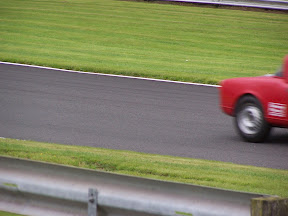My description could make the museum sound somewhat disorganised and lacking in purpose. It is, in fact, very nicely laid out with cars in sensible thematic groups.
You enter the main part of the museum through the “Red Room”, where every car is painted the same colour. The idea, allegedly, is that by having a lot of cars with near identical paint the visitor can more clearly consider line, form and proportion.
 |
| From Haynes Motor Museum |
There are bubble cars but about the smallest “proper” cars are things like the Renault 4CV, Fiat 600 and this Honda.
 |
| From Haynes Motor Museum |
It was nice to see three iconic Citroëns together, a Traction, D-series and SM.
 |
| From Haynes Motor Museum |
Other double chevron cars included a lovely little 5CV.
 |
| From Haynes Motor Museum |
As well as the corrugated shed that is the evergreen 2CV.
 |
| From Haynes Motor Museum |
If you prefer your cars low and impractical there is the utterly gorgeous, early De Tomaso Pantera.
 |
| From Haynes Motor Museum |
Or if you like luxurious grand tourers there is a Ferrari 400i.
 |
| From Haynes Motor Museum |
The Ford Cortina is more down-to-earth. In fact this is the most basic 1.3-litre, two-door version of the mark four ‘tina. Funnily enough there is a dark blue car of exactly the same type (2-door, 1.3) local to my home. I wonder how many others there are?
 |
| From Haynes Motor Museum |
A mark-three Ford Fiesta surely belongs in the car park and not behind a velvet rope. This is one of the experimental Fiestas fitted with a three-cylinder, two stroke engine.
 |
| From Haynes Motor Museum |
I found this Bristol 403 impossible to resist. Sleek and spacious the Bristol was incredibly advanced for its day, with integrated bumpers mounted on rubber to absorb impacts, bonded in rear window and impressively low aerodynamic drag. With a 100bhp version of the BMW-derived two-litre, six cylinder engine the 403 could exceed 100mph. It could also carry four people, plenty of luggage and had decent ventilation. All of which makes it easy to understand why it was priced to compete with Aston Martins and Bentleys.
 |
| From Haynes Motor Museum |
All of which can only give a taste of the breadth of the collection. If I get the opportunity I’ll post more photos.







































